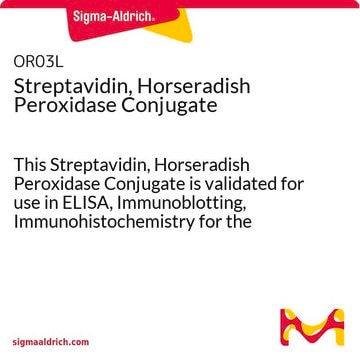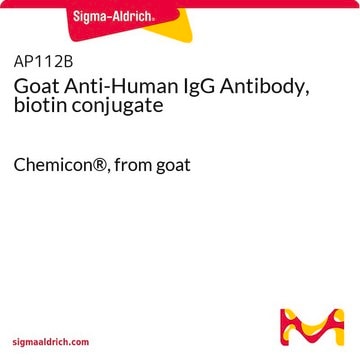11089161001
Roche
Streptavidin-AP conjugate
solution, pkg of 1 mL (1,000U)
Synonym(s):
streptavidin
Sign Into View Organizational & Contract Pricing
All Photos(1)
About This Item
UNSPSC Code:
12352200
Recommended Products
form
solution
Quality Level
packaging
pkg of 1 mL (1,000U)
manufacturer/tradename
Roche
storage temp.
2-8°C
Related Categories
General description
Streptavidin is covalently coupled to alkaline phosphatase (AP) for the preparation of streptavidin-AP-conjugate.
Alkaline Phosphatase
Alkaline Phosphatase is often used as a label in enzyme immunoassays. AP converts the sensitive substrate X-phosphate/NBT into a stable, water soluble product.
Alkaline Phosphatase
Alkaline Phosphatase is often used as a label in enzyme immunoassays. AP converts the sensitive substrate X-phosphate/NBT into a stable, water soluble product.
Application
Streptavidin-AP has been used to detect biotinylated compounds using:
- ELISA
- Immunohistocytochemistry
- Western blot
Physical form
Solution, stablilized in 50 mM Triethanolamine buffer, 3 M NaCl, 1 mM MgCl2, 0.1 mM ZnCl2, 10 mg/ml bovine serum albumin, pH 7.6.
Preparation Note
Working solution: 50 - 1,000 mU/ml (i.e., stock solution can be diluted). Dilute the conjugate stock solution in 100 mM Tris-HCl, 150 mM NaCl, pH 7.5.
Working concentration: Working concentration of conjugate will depend on the application and substrate. Indicated concentrations should be taken as a guideline.
ELISA: 50 - 200 mU/ml (1:5000 - 1:20,000 dilution)
Immunohisto/cytochemistry: 250 - 1,000 mU/ml (1:1000 - 1:4000 dilution)
Western blot: 200 - 500 mU/ml (1:2000 - 1:5000 dilution)
Stability: The concentrated stock solution is stable when stored at 2 to 8°C until the expiration date printed on the label. Do not freeze!
Working concentration: Working concentration of conjugate will depend on the application and substrate. Indicated concentrations should be taken as a guideline.
ELISA: 50 - 200 mU/ml (1:5000 - 1:20,000 dilution)
Immunohisto/cytochemistry: 250 - 1,000 mU/ml (1:1000 - 1:4000 dilution)
Western blot: 200 - 500 mU/ml (1:2000 - 1:5000 dilution)
Stability: The concentrated stock solution is stable when stored at 2 to 8°C until the expiration date printed on the label. Do not freeze!
Other Notes
For life science research only. Not for use in diagnostic procedures.
related product
Product No.
Description
Pricing
Signal Word
Warning
Hazard Statements
Precautionary Statements
Hazard Classifications
Skin Sens. 1
Storage Class Code
12 - Non Combustible Liquids
WGK
WGK 1
Flash Point(F)
No data available
Flash Point(C)
No data available
Certificates of Analysis (COA)
Search for Certificates of Analysis (COA) by entering the products Lot/Batch Number. Lot and Batch Numbers can be found on a product’s label following the words ‘Lot’ or ‘Batch’.
Already Own This Product?
Find documentation for the products that you have recently purchased in the Document Library.
Customers Also Viewed
Ablation of BMP signaling hampers the blastema formation in Poecilia latipinna by dysregulating the extracellular matrix remodeling and cell cycle turnover
Patel S, et al.
Zoology (Jena, Germany), 133, 17-26 (2019)
Manuela Sauter et al.
iScience, 25(1), 103677-103677 (2022-01-18)
Atherosclerosis is studied in models with dysfunctional lipid homeostasis-predominantly the ApoE-/- mouse. The role of antigen-presenting cells (APCs) for lipid homeostasis is not clear. Using a LacZ reporter mouse, we showed that CD11c+ cells were enriched in aortae of ApoE-/-
Manuela Sauter et al.
STAR protocols, 3(3), 101664-101664 (2022-09-14)
Different types of immune cells are involved in atherogenesis and may act atheroprotective or atheroprogressive. Here, we describe an in vitro approach to analyze CD11c+ cells and CD11c+-derived ApoE in atherosclerosis. The major steps include harvesting mouse bone marrow, plating
Johan L K Van Hove et al.
Molecular genetics and metabolism, 95(4), 201-205 (2008-11-01)
We investigated in a patient with holocarboxylase synthetase deficiency, the relation between the biochemical and genetic factors of the mutant protein with the pharmacokinetic factors of successful biotin treatment. A girl exhibited abnormal skin at birth, and developed in the
Muhammad Assad Aslam et al.
EMBO reports, 22(2), e51184-e51184 (2021-01-08)
Differentiation of naïve peripheral B cells into terminally differentiated plasma cells is characterized by epigenetic alterations, yet the epigenetic mechanisms that control B-cell fate remain unclear. Here, we identified a role for the histone H3K79 methyltransferase DOT1L in controlling B-cell
Our team of scientists has experience in all areas of research including Life Science, Material Science, Chemical Synthesis, Chromatography, Analytical and many others.
Contact Technical Service











